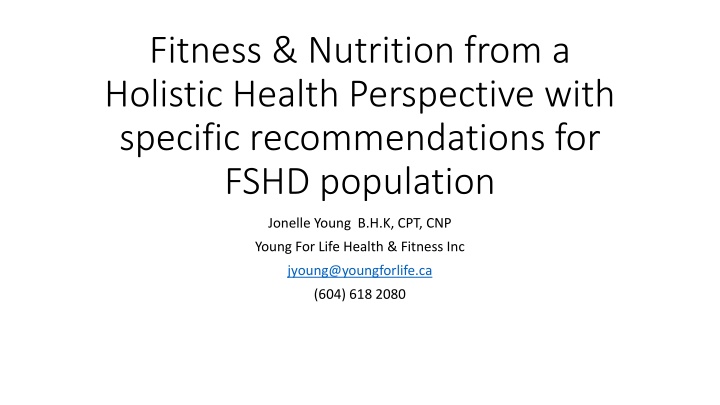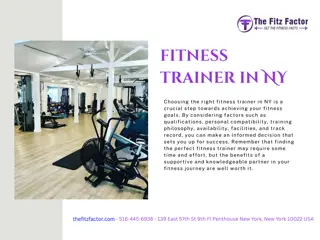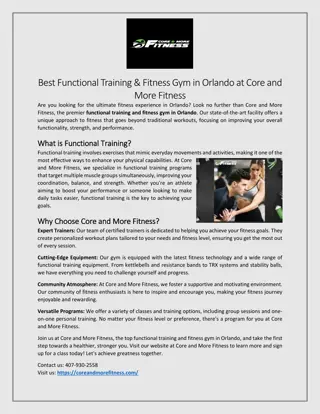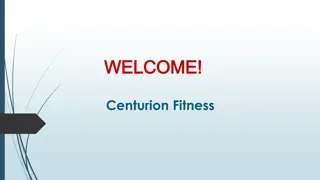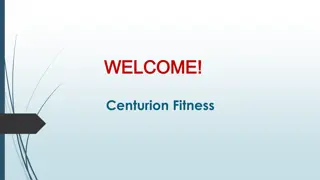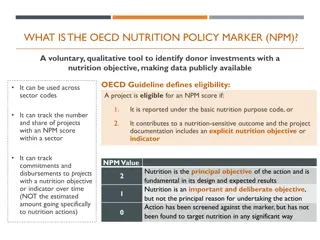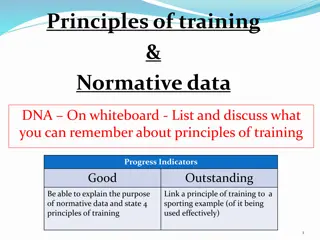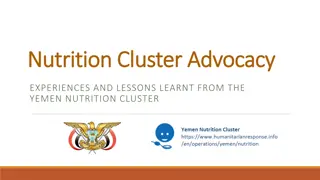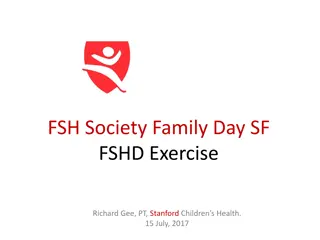Holistic Approach to Fitness & Nutrition for FSHD Population
Enhance your fitness and nutrition from a holistic health perspective with specific recommendations tailored for individuals with FSHD. Jonelle Young, a certified holistic health practitioner, provides insight into interconnecting healthspan and lifespan while emphasizing the importance of exercise and fitness. Learn about FSHD exercise protocol, the distinction between exercise and fitness, and the impact of stress on overall well-being. Dive into the world of holistic health with Young for Life!
Download Presentation

Please find below an Image/Link to download the presentation.
The content on the website is provided AS IS for your information and personal use only. It may not be sold, licensed, or shared on other websites without obtaining consent from the author.If you encounter any issues during the download, it is possible that the publisher has removed the file from their server.
You are allowed to download the files provided on this website for personal or commercial use, subject to the condition that they are used lawfully. All files are the property of their respective owners.
The content on the website is provided AS IS for your information and personal use only. It may not be sold, licensed, or shared on other websites without obtaining consent from the author.
E N D
Presentation Transcript
Fitness & Nutrition from a Holistic Health Perspective with specific recommendations for FSHD population Jonelle Young B.H.K, CPT, CNP Young For Life Health & Fitness Inc jyoung@youngforlife.ca (604) 618 2080
Young For Life credentials and Affiliates University of British Columbia CanFit Pro, VSB, BCIT, Langara College Institute of Holistic Nutrition Foundation Training Functional Movement Systems International Society of Orthomolecular Medicine
Disclaimer Educational Purposes Only Information is for knowledge and does not represent medical advice General group discussion vs specific client protocol Scope: Anatomy & Exercise Physiology, Strength Training, Fitness vs Exercise, Nutrition and Holistic Health & Lifestyle Health & Wellness Coach vs Educational Researcher Scientific Evidence vs Anecdotal Evidence
Holistic Health Interconnection Healthspan & Lifespan Mind Body Spirit: Collective Impact upon body Exercise vs Fitness Emotional Stress vs Physical Stress vs Mental Stress Good Stress (Eustress ) vs Bad Stress (Distress) note: the body does not distinguish between types of stress. Stress is stress on the physical body. The positive benefit of eustress is expressed through the emotional and mental health.
Reference to FSHD Exercise Protocol by Dr. Mark Tarnopolsky Increase Endurance 3x Week, 30 -35 min, at 60-65% of VO2 Max *take day off to recover Strength Train 3 sets x 12-15 repetitions *NO 2days in a row or at least the same muscle *NO exercise with free weights over head or above shoulder
Exercise and Fitness Exercise is a physical activity and movement of the body. Exercise is what you do, to increase your Fitness Fitness is an outcome of performing Exercise. Specific types of exercise affect the level and type of Fitness gained. Exercise can be gentle or intense (walking vs running), short or long (5 mins vs 45 mins), Cardiovascular vs Strength (cycling vs strength). Fitness can be Cardiovascular vs Muscular Strength and Aerobic vs Anaerobic (endurance vs power).
Healthy Exercise Principles to Consider All Populations: Include both Cardiovascular and Strength to overall program Start slowly, increase gradually Incorporate RPE if no VO2Max available Find an activity you enjoy Allow adequate recovery time between training sessions Additional FSHD considerations: Aerobic Based Cardiovascular Exercise to target Oxidative Metabolism vs Anaerobic Metabolism Muscular Strength should be Endurance based vs Hypertrophy or Power Minimize protein breakdown and Promote Protein Synthesis and Complete Muscle Recovery
Calculate Adequate Protein Requirement Consume ONLY required amount of protein based on individual daily needs including any training program. Excess unused protein not needed as fuel for energy, converts to storage fat. For the average person: .8-1.0 grams of protein per kg body weight per day (depending upon male/female, age, training needs ) 1-1.2grams of protein per kg body weight (for heavy strength trainers, growing teenagers, pregnant, elderly or those recovering from surgery or injury ) Dr Tarnopolsky recommends 1.2-1.4 grams protein per kg body weight per day for those with FSHD
Nutrient Timing, Usage and Recovery Worth considering and discussing with FSHD community and practitioners: BCAAs: Isoleucine, Leucine, Valine What: Branch Chain Amino Acids are Essential Amino Acids consist of Why: prevent muscle atrophy and enhance aerobic endurance *LEUCINE in particular increases protein synthesis, so the synthesis is greater than the protein breakdown during exercise. Greater repair means greater growth. Also affects hGH, decreases muscle soreness and tiredness so reduces fatigue thereby, increasing aerobic capacity L-Glutamine: when body under stress What: considered a conditionally Essential Amino Acid as it depletes quickly Why: maintain muscle mass, prevent muscle breakdown, aids in tissue healing and injury repair not only for muscles but any tissue including gut lining and sensitive digestive tract
Reference to Dr Mark Tarnopolsky Nutraceutical Recommendation for FSHD CoQ10 200 mg ALA 200 mg Vit E 400 mg Creatine Monohydrate 5 g
Holistic Nutrition and Supplementation All Populations Including specific FSHD considerations Further to general population, Increase protein intake to 1.2- 1.4 grams per kg body weight Address nutrient deficiency and consider increasing/maximizing mitochondrial health through nutraceutical supplementation and lifestyle Eat whole, clean, minimally or unprocessed, nutrient dense foods as much as possible Eat lean proteins, healthy fats, and slow burning complex carbohydrates Optimize micronutrients and fluid intake namely water
Antioxidant Network Vitamin C Vitamin E CoQ10 Glutathione: Alpha Lipoic Acid (better to take precursor NAC for better absorption) *ALA is the KING of AO Network because it UpRegulates the other 4. it is both water/fat soluble and is produced directly in the mitochondria. ALA production decreases naturally with age, so very important to incr.
Final Considerations Biological Aging is an inevitable natural process that occurs. Period. Difference between Health Span and Life Span is mitigating the factors affecting Biological Aging and Cellular Degeneration (specifically mitochondrial health and vitality) With FSHD, goal is to mitigate the effects and slow down the process in affected muscle fibres by: Decreasing inflammation Decreasing oxidative stress Increasing protein synthesis Increasing mitochondrial health Influencing Epigenetics and Lifestyle Factors can greatly impact the DNA and expression of these genes and factors affecting natural aging process Exercise and Nutrition work synergistically Similarly, as do many nutrients (macro/micro/herbs/functional mushrooms etc) Mental/emotional/physical health each have direct impact on Healthspan & Lifespan Knowledge and education on how these factors influence the body & health is key
